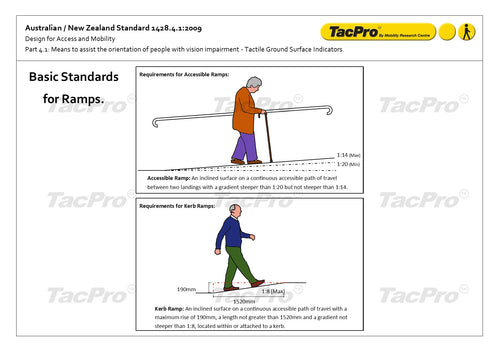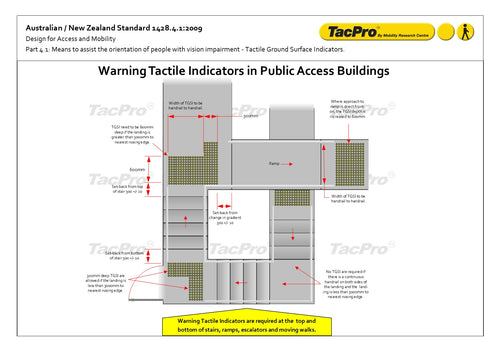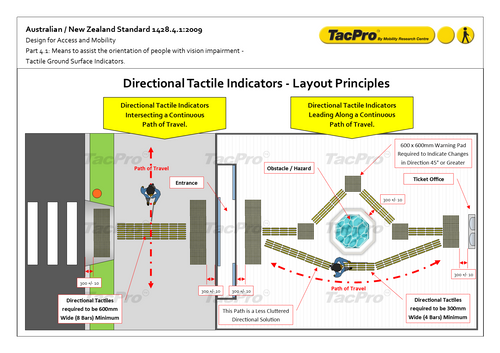
AS/NZS 1428.4.1:2009 – Design for Access and Mobility – Part 4.1: Tactile Ground Surface Indicators.
Clicking here will offer a PDF download of a DRAFT copy of the standard - updating the 2002 version to the current 2009 version. All main principles are the same as the current standard. However, if you want a current official copy, it is available from the Standards Australia Store for $223.32 AUD.
Australian Building Codes Board (ABCB) – National Construction Code.
Clicking here will take you to the ABCB website - Vol 1, Part D3, Access for people with a disability (requires free registration). Scrolling almost to the bottom of the page, you will see section D3.8 Tactile Indicators - this (and the exemptions in section D3.4) are the only reference to Tactile Indicators in this extensive three volume code. These two sections are paraphrased at the bottom of this page, on our website.


 Directional / Leading Tactile Indicators incorporate rows of parallel bars with rounded ends spaced 50mm apart, end to end, and at 75mm centres side by
side. They also have a chamfered
side with a base of 35mm by
approx. 285mm long and 5mm
high.
Directional / Leading Tactile Indicators incorporate rows of parallel bars with rounded ends spaced 50mm apart, end to end, and at 75mm centres side by
side. They also have a chamfered
side with a base of 35mm by
approx. 285mm long and 5mm
high. 30% minimum luminance contrast to the surrounding ground surface is required where the Tactile Indicator is in the form of a precast concrete paver or tile or mat with a uniform colour (defined as being ‘integrated’).
45% minimum luminance contrast to the surrounding ground surface is required where the Tactile Indicator is an individually drilled and fixed stud or bar (defined as ‘discreet’).
60% minimum luminance contrast to the surrounding ground surface is required where the individually drilled and fixed Tactiles have a different colour top than the side - the 25mm diameter top must exhibit the minimum 60% luminance contrast.
30% minimum luminance contrast to the surrounding ground surface is required where the Tactile Indicator is in the form of a precast concrete paver or tile or mat with a uniform colour (defined as being ‘integrated’).
45% minimum luminance contrast to the surrounding ground surface is required where the Tactile Indicator is an individually drilled and fixed stud or bar (defined as ‘discreet’).
60% minimum luminance contrast to the surrounding ground surface is required where the individually drilled and fixed Tactiles have a different colour top than the side - the 25mm diameter top must exhibit the minimum 60% luminance contrast.
 TacPro Note: Luminance meters are available to check contrast levels but common sense often prevails with a simple rule of thumb – light colours on dark ground surfaces, and vice versa. Issues only arise when building owners and architects consider aesthetics over public safety and attempt to blend the tactiels into the surrounding ground surface. Whilst not mandatory, Safety Yellow has been proven to provide the most effective contrast on almost any surface.
TacPro Note: Luminance meters are available to check contrast levels but common sense often prevails with a simple rule of thumb – light colours on dark ground surfaces, and vice versa. Issues only arise when building owners and architects consider aesthetics over public safety and attempt to blend the tactiels into the surrounding ground surface. Whilst not mandatory, Safety Yellow has been proven to provide the most effective contrast on almost any surface. Directional / Leading Tactile Indicators are installed to give directional orientation in open spaces in the absence of other directional tactiles cues, for instance, a building line wall, fence, curb or handrail.
There are two main functions of these indicators – one is to ‘lead’ the pedestrian along an accessible path of travel to a sevice point such as a telephone, help point or ticket office. The other is to intersect the accessible path of travel to give direction to points of reference not on the path such as mid-block pedestrian crossings, public transport access points or entry points to significant public buildings.
Directional / Leading Tactile Indicators are installed to give directional orientation in open spaces in the absence of other directional tactiles cues, for instance, a building line wall, fence, curb or handrail.
There are two main functions of these indicators – one is to ‘lead’ the pedestrian along an accessible path of travel to a sevice point such as a telephone, help point or ticket office. The other is to intersect the accessible path of travel to give direction to points of reference not on the path such as mid-block pedestrian crossings, public transport access points or entry points to significant public buildings.